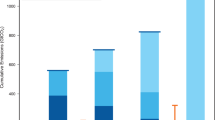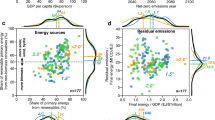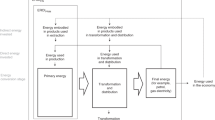Abstract
Low-carbon energy transitions aim to stay within a carbon budget that limits potential climate change to 2 °C—or well below—through a substantial growth in renewable energy sources alongside improved energy efficiency and carbon capture and storage. Current scenarios tend to overlook their low net energy returns compared to the existing fossil fuel infrastructure. Correcting from gross to net energy, we show that a low-carbon transition would probably lead to a 24–31% decline in net energy per capita by 2050, which implies a strong reversal of the recent rising trends of 0.5% per annum. Unless vast end-use efficiency savings can be achieved in the coming decades, current lifestyles might be impaired. To maintain the present net energy returns, solar and wind renewable power sources should grow two to three times faster than in other proposals. We suggest a new indicator, ‘energy return on carbon’, to assist in maximizing the net energy from the remaining carbon budget.
This is a preview of subscription content, access via your institution
Access options
Access Nature and 54 other Nature Portfolio journals
Get Nature+, our best-value online-access subscription
$29.99 / 30 days
cancel any time
Subscribe to this journal
Receive 12 digital issues and online access to articles
$119.00 per year
only $9.92 per issue
Buy this article
- Purchase on Springer Link
- Instant access to full article PDF
Prices may be subject to local taxes which are calculated during checkout


Similar content being viewed by others
Change history
03 April 2018
In the version of this Analysis originally published, the value of the pessimistic EROI for the geothermal energy source in Table 1 was incorrectly given as 14:1; it should have read 9:1. This has now been corrected in all versions of the Analysis.
References
Cleveland, C., Costanza, R., Hall, C. & Kaufmann, R. Energy and the US economy: a biophysical perspective. Science 225, 890–897 (1984).
Stern, D. I. The role of energy in economic growth. Ann. N. Y. Acad. Sci. 1219, 26–51 (2011).
Chontanawat, J., Hunt, L. & Pierse, R. Does energy consumption cause economic growth? Evidence from a systematic study of over 100 countries. J. Policy Model. 30, 209–220 (2008).
Ayres, R. U., van den Bergh, J. C. J. M., Lindenberger, D. & Warr, B. The underestimated contribution of energy to economic growth. Struct. Chang. Econ. Dyn. 27, 79–88 (2013).
Perspectives for the Energy Transition—Investment needs for a Low-Carbon Energy System (OECD/IEA and IRENA, 2017).
Jacobson, M. et al. 100% clean and renewable wind, water, and sunlight all-sector energy roadmaps for 139 countries of the world. Joule 1, 108–121 (2017).
Hall, C. Energy Return on Investment: A Unifying Principle for Biology, Economics, and Sustainability. (Springer: Berlin, 2017).
Murphy, D. & Hall, C. Year in review—EROI or energy return on (energy) invested. Ann. N. Y. Acad. Sci. 1185, 102–118 (2010).
Murphy, D. J., Hall, C. A. S., Dale, M. & Cleveland, C. Order from chaos: a preliminary protocol for determining the EROI of fuels. Sustainability 3, 1888–1907 (2011).
Mulder, K. & Hagens, N. Energy return on investment: toward a consistent framework. AMBIO 37, 74–79 (2008).
Fagnart, J. & Germain, M. Net energy ratio, EROEI and the macroeconomy. Struct. Change Econ. Dyn. 37, 121–126 (2016).
World Energy Balances (OECD/IEA, accessed on 14 June 2017); https://doi.org/10.1787/data-00512-en
Hall, C. A. S., Balogh, S. & Murphy, D. J. R. What is the minimum EROI that a sustainable society must have? Energies 2, 25–47 (2009).
Poisson, A. & Hall, C. A. Time series EROI for Canadian oil and gas. Energies 6, 5940–5959 (2013).
World Energy Flow in 2011 (Lawrence Livermore National Library, 2011).
Gagnon, N., Hall, C. A. S. & Brinker, L. A preliminary investigation of energy return on energy investment for global oil and gas production. Energies 2, 490–503 (2009).
Hall, C. A. S., Lambert, J. G. & Balogh, S. B. EROI of different fuels and the implications for society. Energy Policy 64, 141–152 (2014).
Adoption of the Paris Agreement FCCC/CP/2015/L.9/Rev.1 (UNFCCC, 2015).
McGlade, C. & Ekins, P. The geographical distribution of fossil fuels unused when limiting global warming to 2 °C. Nature 517, 187–190 (2015).
Hall, C. A. S., Powers, R. & Schoenberg, W. in Biofuels, Solar and Wind as Renewable Energy Systems (ed. D. Pimentel) 109–132 (Springer, Dordrecht, 2008).
World Population Prospects: The 2015 Revision, Volume II: Demographic Profiles (Department of Economic and Social Affairs, Population Division.United Nations, 2015).
World Energy Outlook (International Energy Agency, 2016).
Rogelj, J. et al. Differences between carbon budget estimates unravelled. Nat. Clim. Change 6, 245–252 (2016).
Raugei, M., Fullana-i-Palmer, P. & Fthenakis, V. The energy return on energy investment (EROI) of photovoltaics: methodology and comparisons with fossil fuel life cycles. Energy Policy 45, 576–582 (2012).
Weißbach, D. et al. Energy intensities, EROIs (energy returned on invested), and energy payback times of electricity generating power plants. Energy 52, 210–221 (2013).
Raugei, M. Comments on “Energy intensities, EROIs (energy returned on invested), and energy payback times of electricity generating power plants”—making clear of quite some confusion. Energy 59, 781–782 (2013).
Raugei, M., Carbajales-Dale, M., Barnhart, C. & Fthenakis, V. Rebuttal: “Comments on ‘Energy intensities, EROIs (energy returned on invested), and energy payback times of electricity generating power plants’—making clear of quite some confusion”. Energy 82, 1088–1091 (2015).
Ferroni, F. & Hopkirk, R. Energy return on energy invested (ERoEI) for photovoltaic solar systems in regions of moderate insolation. Energy Policy 94, 336–344 (2016).
Leccisi, E., Raugei, M. & Fthenakis, V. The energy and environmental performance of ground-mounted photovoltaic systems—a timely update. Energies 9, 622 (2016).
Lambert, J. G., Hall, C. A. S., Balogh, S., Gupta, A. & Arnold, M. Energy, EROI and quality of life. Energy Policy 64, 153–167 (2014).
Means, E. ERoEI for Beginners. Energy Matters http://euanmearns.com/eroei-for-beginners/ (2016).
IPCC Special Report on Carbon Dioxide Capture and Storage (eds Metz, B. et al.) (Cambridge Univ. Press, 2005).
Anderson, K. Duality in climate science. Nat. Geosci. 8, 898–900 (2015).
Anderson, K. & Peters, G. The trouble with negative emissions. Science 354, 182–183 (2016).
Murphy, D. The implications of the declining energy return on investment of oil production. Phil. Trans. R. Soc. A 372, 20130126 (2013).
Louwen, A., van Sark, W., Faaij, A. & Schropp, R. Re-assessment of net energy production and greenhouse gas emissions avoidance after 40 years of photovoltaics development. Nat. Commun. 7, 13728 (2016).
Energy Efficiency Market Report 2016 (IEA, 2016).
van den Bergh, J. C. J. M. & Botzen, W. J. W. A lower bound to the social cost of CO2 emissions. Nat. Clim. Chang. 4, 253–258 (2014).
Peters, G. P., Andrew, R. M., Solomon, S. & Friedlingstein, P. Measuring a fair and ambitious climate agreement using cumulative emissions. Environ. Res. Lett. 10, 105004 (2015).
Moriarty, P. & Honnery, D. What is the global potential for renewable energy? Renew. Sustain. Energy Rev. 16, 244–252 (2012).
Foley, J. Global consequences of land use. Science 309, 570–574 (2005).
Pandur, Z. et al. in Precious Forests—Precious Earth (ed. Zlatić, M.) 165–184 (InTech, Rijeca, 2015).
Tidball, R. et al. Cost and performance assumptions for modeling electricity generation technologies. Contract 303, 275–3000 (2010).
Renewable Energy Essentials: Hydropower (IEA, 2010).
Acknowledgements
This research was funded by the ‘María de Maeztu Unit of Excellence’ programme of Spain, awarded to ICTA by the Spanish Ministry of Economy and Competitiveness (MINECO), under grant MDM-2015-0552. The authors thank J. Subtil Lacerda and R. Breding for useful comments on the manuscript.
Author information
Authors and Affiliations
Contributions
L.C.K. and J.C.J.M.v.d.B. jointly designed the study and wrote the paper. L.C.K. performed the model calculations.
Corresponding author
Ethics declarations
Competing interests
The authors declare no competing interests.
Additional information
Publisher’s note: Springer Nature remains neutral with regard to jurisdictional claims in published maps and institutional affiliations.
Rights and permissions
About this article
Cite this article
King, L.C., van den Bergh, J.C.J.M. Implications of net energy-return-on-investment for a low-carbon energy transition. Nat Energy 3, 334–340 (2018). https://doi.org/10.1038/s41560-018-0116-1
Received:
Accepted:
Published:
Issue Date:
DOI: https://doi.org/10.1038/s41560-018-0116-1
This article is cited by
-
Systemwide energy return on investment in a sustainable transition towards net zero power systems
Nature Communications (2024)
-
Green finance, energy transition, and natural resources of real estate sector: driving eco-sustainability and sustainable economic growth
Economic Change and Restructuring (2024)
-
Urban–rural income gap and economic sustainability: how does energy transition matters?
Economic Change and Restructuring (2024)
-
Energy requirements and carbon emissions for a low-carbon energy transition
Nature Communications (2022)
-
Sugar taxation for climate and sustainability goals
Nature Sustainability (2022)



